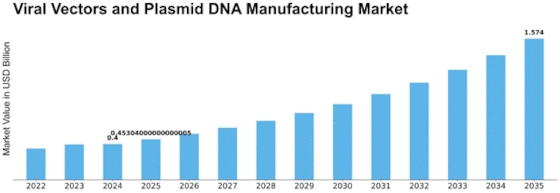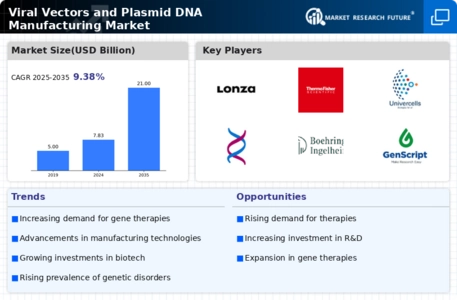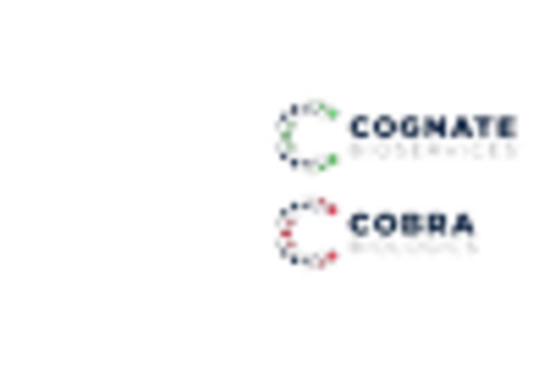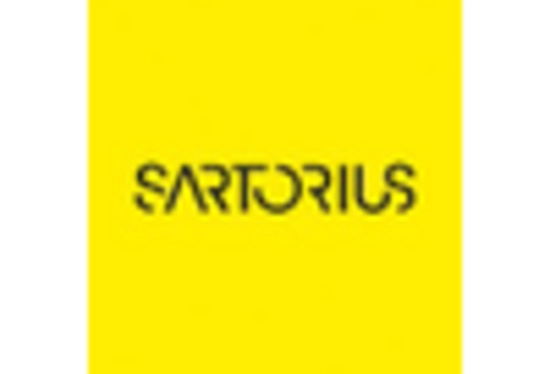Gene Therapy
Vaccine Development
Transgenic Research
Cell and Gene Editing
Viral Vectors
Plasmid DNA
RNA-based Vectors
Viral Transduction
Electroporation
Microinjection
Liposomal Delivery
Pharmaceutical Companies
Biotechnology Firms
Research Institutions
North America
Europe
South America
Asia Pacific
Middle East and Africa
North America Outlook (USD Billion, 2019-2035)
North America Viral Vectors and Plasmid DNA Manufacturing Market by Application Type
Gene Therapy
Vaccine Development
Transgenic Research
Cell and Gene Editing
North America Viral Vectors and Plasmid DNA Manufacturing Market by Type
Viral Vectors
Plasmid DNA
RNA-based Vectors
North America Viral Vectors and Plasmid DNA Manufacturing Market by Technology Type
Viral Transduction
Electroporation
Microinjection
Liposomal Delivery
North America Viral Vectors and Plasmid DNA Manufacturing Market by End Use Type
Pharmaceutical Companies
Biotechnology Firms
Research Institutions
North America Viral Vectors and Plasmid DNA Manufacturing Market by Regional Type
US
Canada
US Outlook (USD Billion, 2019-2035)
US Viral Vectors and Plasmid DNA Manufacturing Market by Application Type
Gene Therapy
Vaccine Development
Transgenic Research
Cell and Gene Editing
US Viral Vectors and Plasmid DNA Manufacturing Market by Type
Viral Vectors
Plasmid DNA
RNA-based Vectors
US Viral Vectors and Plasmid DNA Manufacturing Market by Technology Type
Viral Transduction
Electroporation
Microinjection
Liposomal Delivery
US Viral Vectors and Plasmid DNA Manufacturing Market by End Use Type
Pharmaceutical Companies
Biotechnology Firms
Research Institutions
CANADA Outlook (USD Billion, 2019-2035)
CANADA Viral Vectors and Plasmid DNA Manufacturing Market by Application Type
Gene Therapy
Vaccine Development
Transgenic Research
Cell and Gene Editing
CANADA Viral Vectors and Plasmid DNA Manufacturing Market by Type
Viral Vectors
Plasmid DNA
RNA-based Vectors
CANADA Viral Vectors and Plasmid DNA Manufacturing Market by Technology Type
Viral Transduction
Electroporation
Microinjection
Liposomal Delivery
CANADA Viral Vectors and Plasmid DNA Manufacturing Market by End Use Type
Pharmaceutical Companies
Biotechnology Firms
Research Institutions
Europe Outlook (USD Billion, 2019-2035)
Europe Viral Vectors and Plasmid DNA Manufacturing Market by Application Type
Gene Therapy
Vaccine Development
Transgenic Research
Cell and Gene Editing
Europe Viral Vectors and Plasmid DNA Manufacturing Market by Type
Viral Vectors
Plasmid DNA
RNA-based Vectors
Europe Viral Vectors and Plasmid DNA Manufacturing Market by Technology Type
Viral Transduction
Electroporation
Microinjection
Liposomal Delivery
Europe Viral Vectors and Plasmid DNA Manufacturing Market by End Use Type
Pharmaceutical Companies
Biotechnology Firms
Research Institutions
Europe Viral Vectors and Plasmid DNA Manufacturing Market by Regional Type
Germany
UK
France
Russia
Italy
Spain
Rest of Europe
GERMANY Outlook (USD Billion, 2019-2035)
GERMANY Viral Vectors and Plasmid DNA Manufacturing Market by Application Type
Gene Therapy
Vaccine Development
Transgenic Research
Cell and Gene Editing
GERMANY Viral Vectors and Plasmid DNA Manufacturing Market by Type
Viral Vectors
Plasmid DNA
RNA-based Vectors
GERMANY Viral Vectors and Plasmid DNA Manufacturing Market by Technology Type
Viral Transduction
Electroporation
Microinjection
Liposomal Delivery
GERMANY Viral Vectors and Plasmid DNA Manufacturing Market by End Use Type
Pharmaceutical Companies
Biotechnology Firms
Research Institutions
UK Outlook (USD Billion, 2019-2035)
UK Viral Vectors and Plasmid DNA Manufacturing Market by Application Type
Gene Therapy
Vaccine Development
Transgenic Research
Cell and Gene Editing
UK Viral Vectors and Plasmid DNA Manufacturing Market by Type
Viral Vectors
Plasmid DNA
RNA-based Vectors
UK Viral Vectors and Plasmid DNA Manufacturing Market by Technology Type
Viral Transduction
Electroporation
Microinjection
Liposomal Delivery
UK Viral Vectors and Plasmid DNA Manufacturing Market by End Use Type
Pharmaceutical Companies
Biotechnology Firms
Research Institutions
FRANCE Outlook (USD Billion, 2019-2035)
FRANCE Viral Vectors and Plasmid DNA Manufacturing Market by Application Type
Gene Therapy
Vaccine Development
Transgenic Research
Cell and Gene Editing
FRANCE Viral Vectors and Plasmid DNA Manufacturing Market by Type
Viral Vectors
Plasmid DNA
RNA-based Vectors
FRANCE Viral Vectors and Plasmid DNA Manufacturing Market by Technology Type
Viral Transduction
Electroporation
Microinjection
Liposomal Delivery
FRANCE Viral Vectors and Plasmid DNA Manufacturing Market by End Use Type
Pharmaceutical Companies
Biotechnology Firms
Research Institutions
RUSSIA Outlook (USD Billion, 2019-2035)
RUSSIA Viral Vectors and Plasmid DNA Manufacturing Market by Application Type
Gene Therapy
Vaccine Development
Transgenic Research
Cell and Gene Editing
RUSSIA Viral Vectors and Plasmid DNA Manufacturing Market by Type
Viral Vectors
Plasmid DNA
RNA-based Vectors
RUSSIA Viral Vectors and Plasmid DNA Manufacturing Market by Technology Type
Viral Transduction
Electroporation
Microinjection
Liposomal Delivery
RUSSIA Viral Vectors and Plasmid DNA Manufacturing Market by End Use Type
Pharmaceutical Companies
Biotechnology Firms
Research Institutions
ITALY Outlook (USD Billion, 2019-2035)
ITALY Viral Vectors and Plasmid DNA Manufacturing Market by Application Type
Gene Therapy
Vaccine Development
Transgenic Research
Cell and Gene Editing
ITALY Viral Vectors and Plasmid DNA Manufacturing Market by Type
Viral Vectors
Plasmid DNA
RNA-based Vectors
ITALY Viral Vectors and Plasmid DNA Manufacturing Market by Technology Type
Viral Transduction
Electroporation
Microinjection
Liposomal Delivery
ITALY Viral Vectors and Plasmid DNA Manufacturing Market by End Use Type
Pharmaceutical Companies
Biotechnology Firms
Research Institutions
SPAIN Outlook (USD Billion, 2019-2035)
SPAIN Viral Vectors and Plasmid DNA Manufacturing Market by Application Type
Gene Therapy
Vaccine Development
Transgenic Research
Cell and Gene Editing
SPAIN Viral Vectors and Plasmid DNA Manufacturing Market by Type
Viral Vectors
Plasmid DNA
RNA-based Vectors
SPAIN Viral Vectors and Plasmid DNA Manufacturing Market by Technology Type
Viral Transduction
Electroporation
Microinjection
Liposomal Delivery
SPAIN Viral Vectors and Plasmid DNA Manufacturing Market by End Use Type
Pharmaceutical Companies
Biotechnology Firms
Research Institutions
REST OF EUROPE Outlook (USD Billion, 2019-2035)
REST OF EUROPE Viral Vectors and Plasmid DNA Manufacturing Market by Application Type
Gene Therapy
Vaccine Development
Transgenic Research
Cell and Gene Editing
REST OF EUROPE Viral Vectors and Plasmid DNA Manufacturing Market by Type
Viral Vectors
Plasmid DNA
RNA-based Vectors
REST OF EUROPE Viral Vectors and Plasmid DNA Manufacturing Market by Technology Type
Viral Transduction
Electroporation
Microinjection
Liposomal Delivery
REST OF EUROPE Viral Vectors and Plasmid DNA Manufacturing Market by End Use Type
Pharmaceutical Companies
Biotechnology Firms
Research Institutions
APAC Outlook (USD Billion, 2019-2035)
APAC Viral Vectors and Plasmid DNA Manufacturing Market by Application Type
Gene Therapy
Vaccine Development
Transgenic Research
Cell and Gene Editing
APAC Viral Vectors and Plasmid DNA Manufacturing Market by Type
Viral Vectors
Plasmid DNA
RNA-based Vectors
APAC Viral Vectors and Plasmid DNA Manufacturing Market by Technology Type
Viral Transduction
Electroporation
Microinjection
Liposomal Delivery
APAC Viral Vectors and Plasmid DNA Manufacturing Market by End Use Type
Pharmaceutical Companies
Biotechnology Firms
Research Institutions
APAC Viral Vectors and Plasmid DNA Manufacturing Market by Regional Type
China
India
Japan
South Korea
Malaysia
Thailand
Indonesia
Rest of APAC
CHINA Outlook (USD Billion, 2019-2035)
CHINA Viral Vectors and Plasmid DNA Manufacturing Market by Application Type
Gene Therapy
Vaccine Development
Transgenic Research
Cell and Gene Editing
CHINA Viral Vectors and Plasmid DNA Manufacturing Market by Type
Viral Vectors
Plasmid DNA
RNA-based Vectors
CHINA Viral Vectors and Plasmid DNA Manufacturing Market by Technology Type
Viral Transduction
Electroporation
Microinjection
Liposomal Delivery
CHINA Viral Vectors and Plasmid DNA Manufacturing Market by End Use Type
Pharmaceutical Companies
Biotechnology Firms
Research Institutions
INDIA Outlook (USD Billion, 2019-2035)
INDIA Viral Vectors and Plasmid DNA Manufacturing Market by Application Type
Gene Therapy
Vaccine Development
Transgenic Research
Cell and Gene Editing
INDIA Viral Vectors and Plasmid DNA Manufacturing Market by Type
Viral Vectors
Plasmid DNA
RNA-based Vectors
INDIA Viral Vectors and Plasmid DNA Manufacturing Market by Technology Type
Viral Transduction
Electroporation
Microinjection
Liposomal Delivery
INDIA Viral Vectors and Plasmid DNA Manufacturing Market by End Use Type
Pharmaceutical Companies
Biotechnology Firms
Research Institutions
JAPAN Outlook (USD Billion, 2019-2035)
JAPAN Viral Vectors and Plasmid DNA Manufacturing Market by Application Type
Gene Therapy
Vaccine Development
Transgenic Research
Cell and Gene Editing
JAPAN Viral Vectors and Plasmid DNA Manufacturing Market by Type
Viral Vectors
Plasmid DNA
RNA-based Vectors
JAPAN Viral Vectors and Plasmid DNA Manufacturing Market by Technology Type
Viral Transduction
Electroporation
Microinjection
Liposomal Delivery
JAPAN Viral Vectors and Plasmid DNA Manufacturing Market by End Use Type
Pharmaceutical Companies
Biotechnology Firms
Research Institutions
SOUTH KOREA Outlook (USD Billion, 2019-2035)
SOUTH KOREA Viral Vectors and Plasmid DNA Manufacturing Market by Application Type
Gene Therapy
Vaccine Development
Transgenic Research
Cell and Gene Editing
SOUTH KOREA Viral Vectors and Plasmid DNA Manufacturing Market by Type
Viral Vectors
Plasmid DNA
RNA-based Vectors
SOUTH KOREA Viral Vectors and Plasmid DNA Manufacturing Market by Technology Type
Viral Transduction
Electroporation
Microinjection
Liposomal Delivery
SOUTH KOREA Viral Vectors and Plasmid DNA Manufacturing Market by End Use Type
Pharmaceutical Companies
Biotechnology Firms
Research Institutions
MALAYSIA Outlook (USD Billion, 2019-2035)
MALAYSIA Viral Vectors and Plasmid DNA Manufacturing Market by Application Type
Gene Therapy
Vaccine Development
Transgenic Research
Cell and Gene Editing
MALAYSIA Viral Vectors and Plasmid DNA Manufacturing Market by Type
Viral Vectors
Plasmid DNA
RNA-based Vectors
MALAYSIA Viral Vectors and Plasmid DNA Manufacturing Market by Technology Type
Viral Transduction
Electroporation
Microinjection
Liposomal Delivery
MALAYSIA Viral Vectors and Plasmid DNA Manufacturing Market by End Use Type
Pharmaceutical Companies
Biotechnology Firms
Research Institutions
THAILAND Outlook (USD Billion, 2019-2035)
THAILAND Viral Vectors and Plasmid DNA Manufacturing Market by Application Type
Gene Therapy
Vaccine Development
Transgenic Research
Cell and Gene Editing
THAILAND Viral Vectors and Plasmid DNA Manufacturing Market by Type
Viral Vectors
Plasmid DNA
RNA-based Vectors
THAILAND Viral Vectors and Plasmid DNA Manufacturing Market by Technology Type
Viral Transduction
Electroporation
Microinjection
Liposomal Delivery
THAILAND Viral Vectors and Plasmid DNA Manufacturing Market by End Use Type
Pharmaceutical Companies
Biotechnology Firms
Research Institutions
INDONESIA Outlook (USD Billion, 2019-2035)
INDONESIA Viral Vectors and Plasmid DNA Manufacturing Market by Application Type
Gene Therapy
Vaccine Development
Transgenic Research
Cell and Gene Editing
INDONESIA Viral Vectors and Plasmid DNA Manufacturing Market by Type
Viral Vectors
Plasmid DNA
RNA-based Vectors
INDONESIA Viral Vectors and Plasmid DNA Manufacturing Market by Technology Type
Viral Transduction
Electroporation
Microinjection
Liposomal Delivery
INDONESIA Viral Vectors and Plasmid DNA Manufacturing Market by End Use Type
Pharmaceutical Companies
Biotechnology Firms
Research Institutions
REST OF APAC Outlook (USD Billion, 2019-2035)
REST OF APAC Viral Vectors and Plasmid DNA Manufacturing Market by Application Type
Gene Therapy
Vaccine Development
Transgenic Research
Cell and Gene Editing
REST OF APAC Viral Vectors and Plasmid DNA Manufacturing Market by Type
Viral Vectors
Plasmid DNA
RNA-based Vectors
REST OF APAC Viral Vectors and Plasmid DNA Manufacturing Market by Technology Type
Viral Transduction
Electroporation
Microinjection
Liposomal Delivery
REST OF APAC Viral Vectors and Plasmid DNA Manufacturing Market by End Use Type
Pharmaceutical Companies
Biotechnology Firms
Research Institutions
South America Outlook (USD Billion, 2019-2035)
South America Viral Vectors and Plasmid DNA Manufacturing Market by Application Type
Gene Therapy
Vaccine Development
Transgenic Research
Cell and Gene Editing
South America Viral Vectors and Plasmid DNA Manufacturing Market by Type
Viral Vectors
Plasmid DNA
RNA-based Vectors
South America Viral Vectors and Plasmid DNA Manufacturing Market by Technology Type
Viral Transduction
Electroporation
Microinjection
Liposomal Delivery
South America Viral Vectors and Plasmid DNA Manufacturing Market by End Use Type
Pharmaceutical Companies
Biotechnology Firms
Research Institutions
South America Viral Vectors and Plasmid DNA Manufacturing Market by Regional Type
Brazil
Mexico
Argentina
Rest of South America
BRAZIL Outlook (USD Billion, 2019-2035)
BRAZIL Viral Vectors and Plasmid DNA Manufacturing Market by Application Type
Gene Therapy
Vaccine Development
Transgenic Research
Cell and Gene Editing
BRAZIL Viral Vectors and Plasmid DNA Manufacturing Market by Type
Viral Vectors
Plasmid DNA
RNA-based Vectors
BRAZIL Viral Vectors and Plasmid DNA Manufacturing Market by Technology Type
Viral Transduction
Electroporation
Microinjection
Liposomal Delivery
BRAZIL Viral Vectors and Plasmid DNA Manufacturing Market by End Use Type
Pharmaceutical Companies
Biotechnology Firms
Research Institutions
MEXICO Outlook (USD Billion, 2019-2035)
MEXICO Viral Vectors and Plasmid DNA Manufacturing Market by Application Type
Gene Therapy
Vaccine Development
Transgenic Research
Cell and Gene Editing
MEXICO Viral Vectors and Plasmid DNA Manufacturing Market by Type
Viral Vectors
Plasmid DNA
RNA-based Vectors
MEXICO Viral Vectors and Plasmid DNA Manufacturing Market by Technology Type
Viral Transduction
Electroporation
Microinjection
Liposomal Delivery
MEXICO Viral Vectors and Plasmid DNA Manufacturing Market by End Use Type
Pharmaceutical Companies
Biotechnology Firms
Research Institutions
ARGENTINA Outlook (USD Billion, 2019-2035)
ARGENTINA Viral Vectors and Plasmid DNA Manufacturing Market by Application Type
Gene Therapy
Vaccine Development
Transgenic Research
Cell and Gene Editing
ARGENTINA Viral Vectors and Plasmid DNA Manufacturing Market by Type
Viral Vectors
Plasmid DNA
RNA-based Vectors
ARGENTINA Viral Vectors and Plasmid DNA Manufacturing Market by Technology Type
Viral Transduction
Electroporation
Microinjection
Liposomal Delivery
ARGENTINA Viral Vectors and Plasmid DNA Manufacturing Market by End Use Type
Pharmaceutical Companies
Biotechnology Firms
Research Institutions
REST OF SOUTH AMERICA Outlook (USD Billion, 2019-2035)
REST OF SOUTH AMERICA Viral Vectors and Plasmid DNA Manufacturing Market by Application Type
Gene Therapy
Vaccine Development
Transgenic Research
Cell and Gene Editing
REST OF SOUTH AMERICA Viral Vectors and Plasmid DNA Manufacturing Market by Type
Viral Vectors
Plasmid DNA
RNA-based Vectors
REST OF SOUTH AMERICA Viral Vectors and Plasmid DNA Manufacturing Market by Technology Type
Viral Transduction
Electroporation
Microinjection
Liposomal Delivery
REST OF SOUTH AMERICA Viral Vectors and Plasmid DNA Manufacturing Market by End Use Type
Pharmaceutical Companies
Biotechnology Firms
Research Institutions
MEA Outlook (USD Billion, 2019-2035)
MEA Viral Vectors and Plasmid DNA Manufacturing Market by Application Type
Gene Therapy
Vaccine Development
Transgenic Research
Cell and Gene Editing
MEA Viral Vectors and Plasmid DNA Manufacturing Market by Type
Viral Vectors
Plasmid DNA
RNA-based Vectors
MEA Viral Vectors and Plasmid DNA Manufacturing Market by Technology Type
Viral Transduction
Electroporation
Microinjection
Liposomal Delivery
MEA Viral Vectors and Plasmid DNA Manufacturing Market by End Use Type
Pharmaceutical Companies
Biotechnology Firms
Research Institutions
MEA Viral Vectors and Plasmid DNA Manufacturing Market by Regional Type
GCC Countries
South Africa
Rest of MEA
GCC COUNTRIES Outlook (USD Billion, 2019-2035)
GCC COUNTRIES Viral Vectors and Plasmid DNA Manufacturing Market by Application Type
Gene Therapy
Vaccine Development
Transgenic Research
Cell and Gene Editing
GCC COUNTRIES Viral Vectors and Plasmid DNA Manufacturing Market by Type
Viral Vectors
Plasmid DNA
RNA-based Vectors
GCC COUNTRIES Viral Vectors and Plasmid DNA Manufacturing Market by Technology Type
Viral Transduction
Electroporation
Microinjection
Liposomal Delivery
GCC COUNTRIES Viral Vectors and Plasmid DNA Manufacturing Market by End Use Type
Pharmaceutical Companies
Biotechnology Firms
Research Institutions
SOUTH AFRICA Outlook (USD Billion, 2019-2035)
SOUTH AFRICA Viral Vectors and Plasmid DNA Manufacturing Market by Application Type
Gene Therapy
Vaccine Development
Transgenic Research
Cell and Gene Editing
SOUTH AFRICA Viral Vectors and Plasmid DNA Manufacturing Market by Type
Viral Vectors
Plasmid DNA
RNA-based Vectors
SOUTH AFRICA Viral Vectors and Plasmid DNA Manufacturing Market by Technology Type
Viral Transduction
Electroporation
Microinjection
Liposomal Delivery
SOUTH AFRICA Viral Vectors and Plasmid DNA Manufacturing Market by End Use Type
Pharmaceutical Companies
Biotechnology Firms
Research Institutions
REST OF MEA Outlook (USD Billion, 2019-2035)
REST OF MEA Viral Vectors and Plasmid DNA Manufacturing Market by Application Type
Gene Therapy
Vaccine Development
Transgenic Research
Cell and Gene Editing
REST OF MEA Viral Vectors and Plasmid DNA Manufacturing Market by Type
Viral Vectors
Plasmid DNA
RNA-based Vectors
REST OF MEA Viral Vectors and Plasmid DNA Manufacturing Market by Technology Type
Viral Transduction
Electroporation
Microinjection
Liposomal Delivery
REST OF MEA Viral Vectors and Plasmid DNA Manufacturing Market by End Use Type
Pharmaceutical Companies
Biotechnology Firms
Research Institutions










Leave a Comment